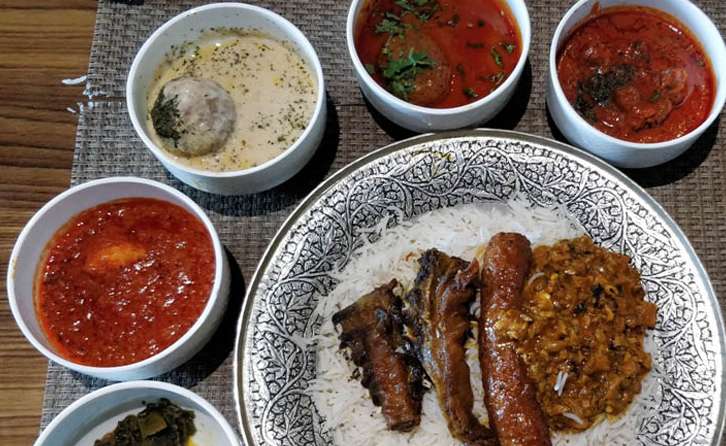Food is our common ground, a universal experience – James Beard, American Chef The valley is often termed as a land of abundance. The breathtaking views, with nature at its very best often leave the mind enthralled and spellbound. One may get easily hypnotized by the majestic snow-capped mountains, glass like lakes and gushing waterfalls.
On first look, the sumptuous natural beauty of Kashmir often overshadows its vibrant culture, exuberant hospitality and an inherent culinary affinity. The transfixing complexion of Kashmir, augmented by the zeal of locals towards culinary proficiency makes Kashmir easy, both on the eyes and the palate. All these factors together make Kashmir, a gourmand’s fantasy. Wazwan- the highlight of Kashmiri cuisine is a must at all major celebrations in the valley. It is joked that the availability of a Vasta waza, the master chef supervising the banquet, often decides the dates of marriages in Kashmir.
The Wazwan is a meat feast governed by its own set of rules and can have anywhere from seven to thirty dishes. This elaborate carnivorous food extravaganza often lasts for more than five hours and ensures that even a glutton is satiated. The Wazwan is known for thick gravies, liberal use of dry fruits, yogurt and ghee. ‘Saffron’ an indigenous spice of Kashmir is extensively used as a flavoring agent for a number of dishes. The cooking is traditionally done in a Vurabal which is an open-air kitchen, built with bricks or stones.
Once prepared, the food is served in large brass plates called Trami. Often in big feasts a trami is shared between four people, seated on a carpet called dasterkhwan. It is customary to wash hands from tash naer, a copper basin kept table side. Lamb seekh kebab, lamb ribs, daeni phoul and waze kokur roast chicken form the inaugural dishes or ‘appetizers’. The main course is a procession of thick gravy dishes like the Rista, the widely acclaimed and popular mutton rogan josh and some of the less spicy dishes like aab gosh.
The Ghustuba prepared in Yakhani gravy is the crowning jewel of Wazwan and generally given towards the end of the feast. Predominantly a non veg affair, some veg dishes like the Chaman which is cottage cheese flavored with tomato sauce and local spices also feature as delicacies. Kahwa a typical Kashmiri tea preparation is used to draw a close to an elaborate feast. It is generally had sitting down, legs stretched and ‘stomach full’. It is a milk less tea preparation with a dash of honey for sweetening.
The culinary art of Wazwan was passed down through heredity and rarely taught to someone outside blood relations. This help made the art exclusive and limited to the region for a long time. A lot of famous personalities have shown weakness for this assorted and aromatic delicacy, most notably the former Prime Minister of India Pandit Jawaharlal Nehru who is known to have extended his visits to the valley for the love of the local cuisine.
Initially inspired by influences from central and west Asia, the Wazwan now has a distinct identity and has evolved into an unparalleled cuisine in terms of variety and flavor. Wazwan, though popular has traditionally been used to adorn local ceremonies.
The grandeur of Wazwan could not be exploited commercially when compared to some of its counterparts such as the Mughlai cuisine. The lack of authentic Wazwan and its restricted availability didn’t help the cause. The accounts given by the Security forces posted in the region provided the much-needed impetus to the popularity of the cuisine in the rest of the nation.
The growing interest in Wazwan, coupled with the recent developments in the valley, most notably the abrogation of Article 370 makes it a perfect time to take this cuisine to a wider audience. The need of the hour is for global food chains such as Swiggy and Zomato to jump on the Wazwan bandwagon and help this cuisine attain a global status in true sense.
The locals must establish specialist restaurants on the lines of Ahdoos, Srinagar, to cater to the needs of ever-increasing tourism industry in the valley. It is high time that the hospitality industry exploits the immense potential of this age-old cuisine and make adequate investments to take this native cuisine to its deserved glory..




















